Original Author: Yilan
Original source: LD Research
Summary
Summary
As the popularity of the new public chain market rises, the concept of characteristic public chains emerges. It may not be Ethereum’s Fork that defeats Ethereum, but a more disruptive and easy-to-use public chain that can help Web3.0 to mature.The development of characteristic public chains is the only way for Web3.0 to shape the next generation of Internet. From the perspective of meeting the needs of large-scale Web3.0 applications,
The continuous iteration of the characteristic public chain is of great significance to the Web3.0 world that requires high-dimensional user experience improvement.
The gradual completion of Ethereum’s merging and layering process is not friendly to high-performance Ethereum Fork, and alternative consensus mechanisms such as DAG, DiemBFT v4 and other featured technology public chains, as well as public chains with modular and innovative architectures, may be in the next public chain. Stand out from the wave of chains. The public chain will also gradually differentiate into wide-area, private-area and specific track directions (such as application chain).
The public chain with healthy ecological construction and the ability to continue to attract original projects can pass through bulls and bears. The public chain under construction carries a lot of unexploded vitality. The development of the public chain is in the complexity of modularization and scalability and the simplicity of the user experience presented to users Find balance.first level title
Introduction
Introduction
Not long ago, Aptos received an investment of US$150 million from FTX at a valuation of US$2.75 billion, with a total financing of US$350 million. This is a particularly impressive achievement in a bear market. Of course, this is not unrelated to the feasible plan of Meta (former Facebook) through obtaining user information and the background carefully designed by a large number of top scientists. The new public chain Solana, which emerged in the last wave of bull market, currently has a bear market FDV of less than 20 billion U.S. dollars, and a near FDV of only 4.1 billion U.S. dollars.
Throughout the development process of the public chain, it can be roughly divided into three stages.
The first stageFrom 2008 to 2013, after Satoshi Nakamoto published the Bitcoin white paper, Bitcoin became popular, and many "cottage coins" aimed at improving Bitcoin appeared, resulting in the first batch of public chains represented by BTC.
second stagesecond stage
From 2014 to 2017, the addition of Turing's completeness made Ethereum a turning point in the development of the public chain. The concept of smart contracts appeared in the blockchain for the first time, and made the public chain have the programmability of running applications, while encrypting With the advent of applications such as cats, people began to truly experience the application display of blockchain technology. Ethereum also established its own ecological barriers in the public chain with the first-mover advantage. The public chains produced during this period include ETH, NEO, QTUM, EOS, etc.The third phase
Since 2018, the iteration of various consensus mechanisms and verification transaction layer technologies has created a batch of high-performance and low-cost public chains, including BSC, Solana, Avax, etc.In the next stage, the development of the public chain will be accompanied by the merger of ETH2.0 and the process of fragmentation expansion. There may be two trends
, after the first type of sharding is completed, the users on the L1 of EVM compatible and the corresponding L2 who were forced to overflow due to high gas fees may return, and the Forks of Ethereum are facing challenges; the second trend is to have unique technologies and innovations The public chain of the architecture will stand out, and the development of the public chain will gradually differentiate into the direction of serving the wide area/private domain and specific tracks (such as the application chain).
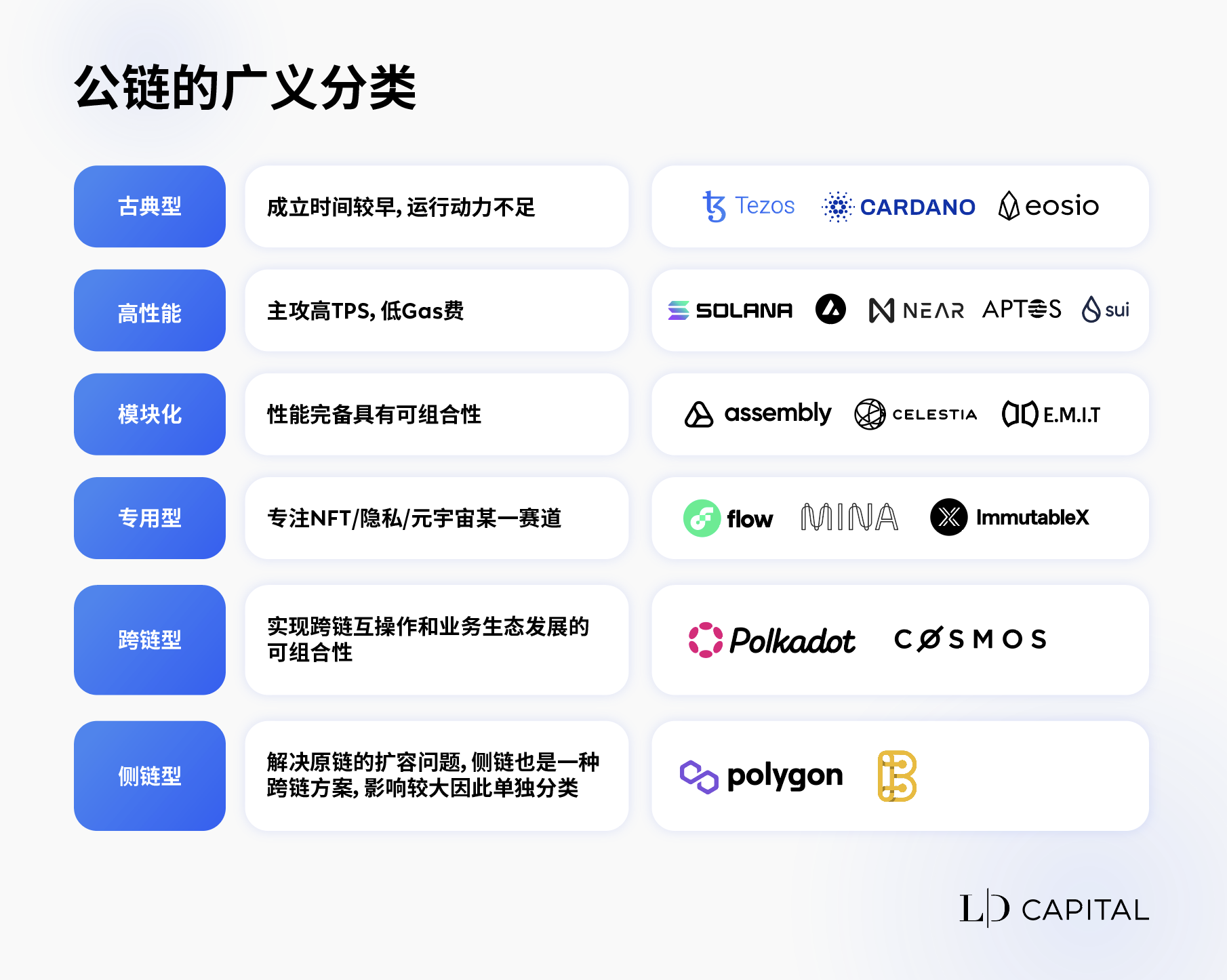
Broad classification of public chains and the concept of characteristic public chainsIt is a concept further stripped from the generalized public chain. It subdivides the characteristics of the public chain in terms of technical features, Product-Market Fit, and value narrative to feel the direction of the public chain iteration. For example:
bybyFeatured, representative public chains include Aptos, Sui, IOTA2.0+Assembly, zk-snark lightweight public chain MINA, EMIT-Core, etc.;
bybyfeatured, representing Flow, Metabit, ImmutableX, Metabit and MINA, etc.;
bybyvalue narrative
With pioneering technology, the public chain market for private domains and specific track fields is still a blue ocean.
first level title
This article mainly discusses five projects that conform to the concept of characteristic public chains in terms of innovative architecture (such as modularization) and core technology.
secondary title
Aptos – Born with a golden key in its mouth, a high-performance public chain using the Move language
1.1 Introduction to Aptos Core Technical Features
consensus mechanism
consensus mechanism
Aptos uses the same optimized BFT (asynchronous Byzantine) as Solana as its consensus mechanism, but unlike Solana, Aptos has added an innovative reputation system, which is especially suitable for decentralized environments and can check data on the chain. When the verifier is unresponsive, the leader can be automatically changed without manual intervention. In addition, the block submission time is also significantly shortened, and the average submission completion time is less than 1 second. This asynchronous mechanism also strengthens network security features against adverse network conditions, network partitions, or DoS attacks on validators, as it does not impose any synchronization assumptions on the network.
Aptos Labs has designed a new technology method Block-STM for flexible transaction programming that supports synchronous processes. STM stands for Software Transactional Memory. In the experimental environment, 32 cores can simultaneously process transactions of 10,000+ accounts In this case, the performance is 20 times higher than that of sequential execution under low contention load, and 9 times higher under high contention load. The expected theoretical TPS reaches 160,000+.
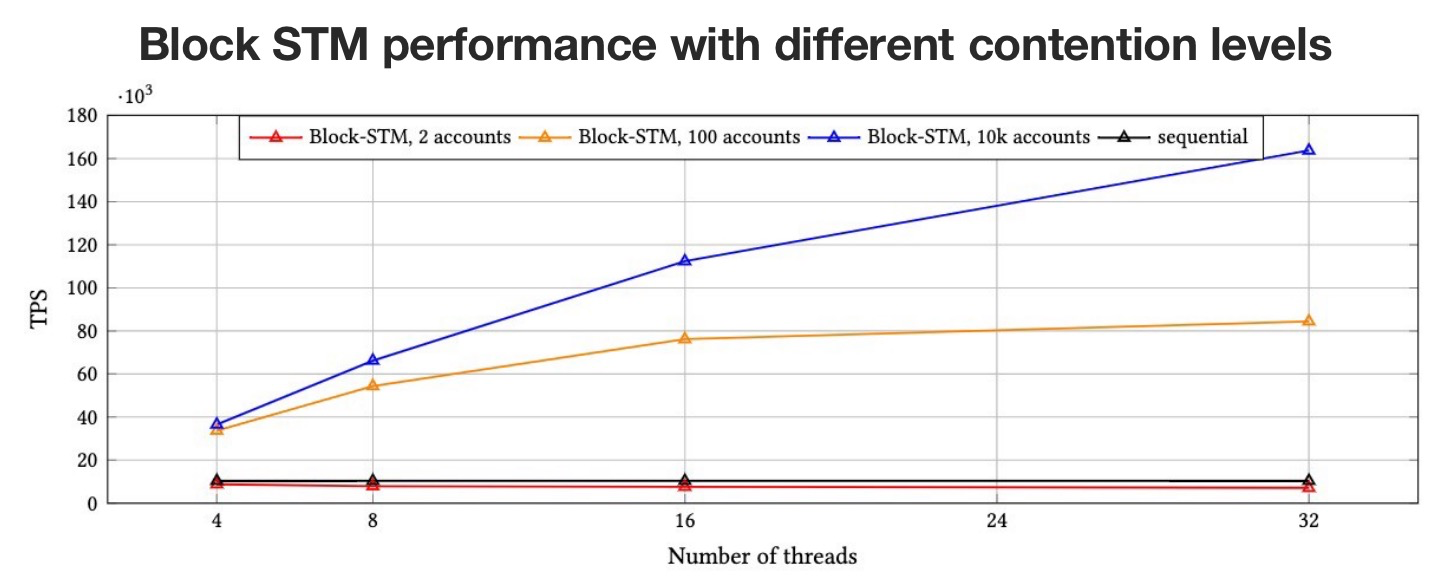
image description
Data source: Aptos Labs
Move programming language
The Aptos development team created the Move programming language to improve blockchain security. Move is not only designed for writing smart contracts, users can also use Move to manage their own accounts, change node settings, adjust commission size and add new features.
Summarizing Aptos' technological innovation in one sentence, its system currently optimizes transactions in parallel through consensus (AptosBFT), execution (Block-STM), and environment (Move) to increase speed and reduce costs.
The Aptos team has made efforts in the ecological construction of five sectors including stable currency, DEX, wallet, lending market and oracle machine. Noteworthy are Thata Labs’ stablecoin project, the first Dex Pontem Network, encrypted wallet Martian, liquid pledge protocol Zaptos, domain name service provider ANS, encrypted wallet Fewcha Wallet, NFT project Aptos Toad Overload, NFT market Topaz, synthetic asset Clone , block explorer Aptosscan, etc., ecological projects are highly native. In addition, many Solana projects have also landed in the Aptos ecosystem first, and Aptos has a strong siphon effect on projects on Solana.
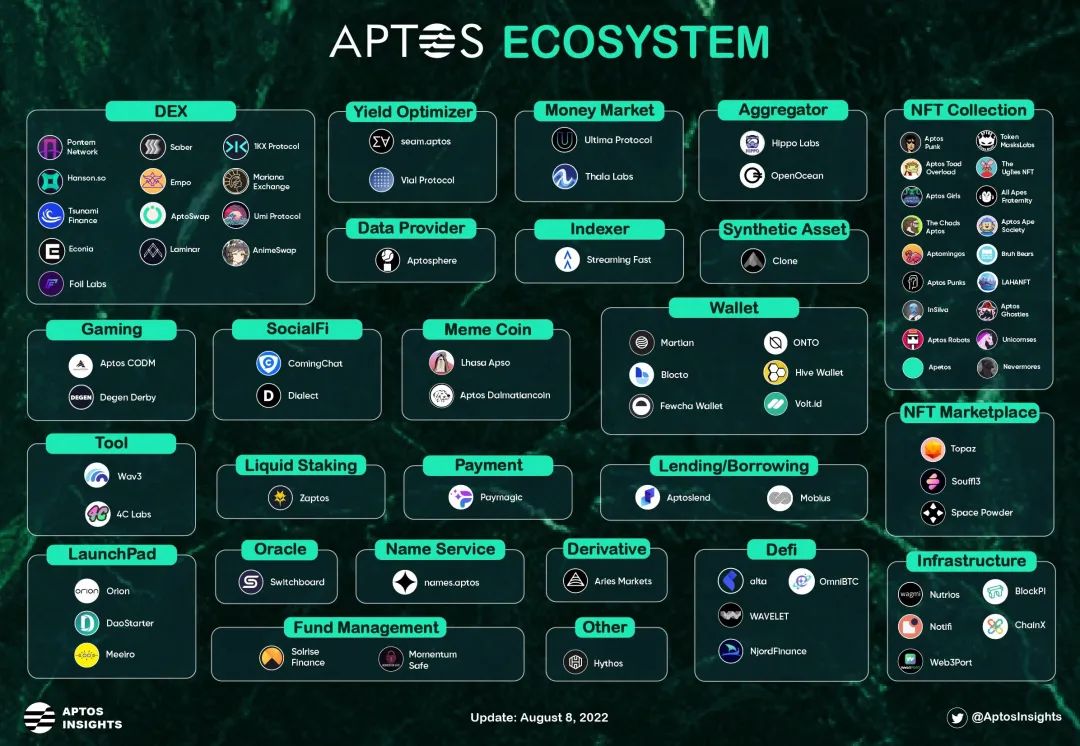
Data source: @AptosInsights
secondary title
Sui – A high-performance public chain that appeared at the same time as Aptos and shared the main features
Sui is a high-performance L1 public chain launched by Mysten Labs (the team comes from the Meta stablecoin Diem and the Novi wallet project). Sui, like Aptos, is trying to solve the blockchain trilemma, but at its center is scaling composable and dynamic NFTs for a wide range of metaverse applications, including gaming, social, and commerce. Sui also achieved good financing results in the bear market (valuation of 2 billion US dollars), and released the token economics model ahead of Aptos.
2.1 Similarities and differences between Sui and Aptos core technologies
In terms of language environment, Sui also uses Move as its native programming language. Although Sui's memory data and code model is slightly different from Aptos. , Sui's Move language makes it clear when in-memory data and code are owned/shared or mutable/immutable, a feature that Aptos does not share.
In terms of consensus mechanism, similar to Aptos, Sui's consensus protocol is also a derivative of HotStuff. Both Sui’s and Aptos’ consensus mechanisms minimize the communication required between validators to process transactions to achieve lower latency. AptosBFT is partially asynchronous. Sui's design for achieving consensus is to separate the protocol's mempool from the consensus layer, whereas most PoS L1s have a single consensus protocol.
In terms of SDK innovation, although Aptos also has an SDK for improving DX/UX, Sui's SDK has made interesting attempts to connect other ecosystems and non-encrypted use cases, such as opening game APIs, game developers will be able to communicate with Sui's ecosystem (users, other dApps, assets) and the Move language interact seamlessly; allowing dApp developers to lead the community by facilitating the portability of digital assets from other ecosystems to Sui as well as develop front-end tools for "Handshake" as A channel for users to distribute, claim/redeem Sui digital assets (e.g. payments, merchant coupons) to crypto and non-crypto users.
At present, SUI has issued incentives for testnet registration, and released the Chrome extension self-custodial wallet "Sui Wallet". The ecological progress of Sui seems to be relatively slow. In addition to the wallet, there are also browsers, games, and social metaverse projects currently under construction. It can be seen that Sui's ecological positioning is also more inclined to the expansion of a wide range of metaverse applications including games, social networking, and business.
secondary title
IOTA2.0+Assembly -- high-performance public chain that satisfies modularity and adopts DAG technology
As the settlement layer of Assembly, IOTA took the lead in adopting DAG technology, called Tangle. Strictly speaking, Tangle is not a blockchain technology, which is also its unique pioneering technology.
3.1 Introduction to the core technical features of Assembly
ComposabilityComposability
On the one hand, Assembly can be regarded as layer 1.5, which is a smart contract architecture layer, and each smart contract chain built on Assembly is the real Layer 2.The combination of IOTA2.0+Assembly splits the L1+L2 model of other public chains into 2.5 layers, which shows a lot of modularity, and because there is a separate Assembly smart contract architecture layer, various possibilities can be combined, such as Coupling arrangement with different data availability layer/execution layer/settlement layer.
costOn the one hand, the technical characteristics of Assembly determine that the network fee for building applications or interactive use based on Assembly will be the lowest in the entire public chain market, and the fee will also remain at a stable level.
safetysafety
On the one hand, Assembly uses a form similar to the ETH2.0 fraud proof Rollup. Each verifier uses the pledged assets as a security guarantee. Any third party can provide fraud evidence when the verifier updates the wrong chain status by monitoring the activities of the chain, and Earn rewards. This ensures that as long as there is only one honest validator in the validator committee, the state of the chain can be protected from malicious transformation.
There are currently 213 projects under development on IOTA 2.0, which can then be migrated seamlessly after the Assembly mainnet goes live. Some projects carry the concept of Industry 4.0 and create synergy with off-chain. Among the popular projects are IOTAlias, IOTA charging station, etc.
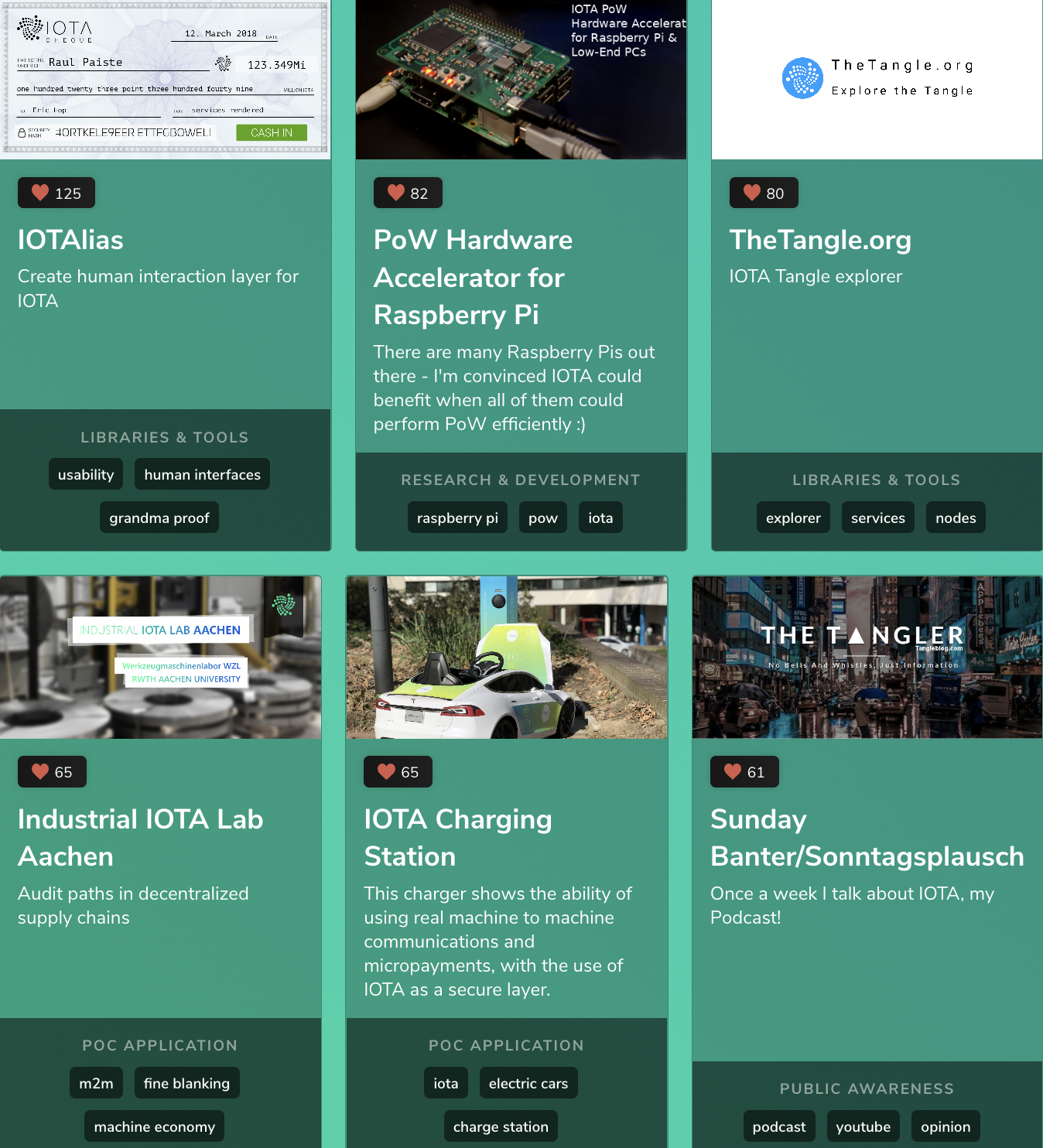
image description
IOTA2.0+Assembly's unique Tangle model based on DAG consensus architecture and modular structure is one of the few distinctive public chains in the market, but its ecological construction speed is relatively slow.
secondary title
The core concept of Mina is "succinct blockchain", and the block size of all transactions processed in the entire Mina network is limited to 22 KB. And the latest block will contain the latest state of the entire blockchain, users only need a zk-SNARK proof to fully verify the state of the current blockchain within a few milliseconds.

image description
Data source: minaprotocol.com
Unlike other layer 1 blockchains that grow with each block added, Mina is able to maintain a fixed size by using a series of self-referential cryptographic proofs. It's helpful to think of Mina's recursive cryptography process as taking a picture of the blockchain. Whenever a new block is added, another photo of the new block is taken with the existing blockchain, limiting the size of the blockchain to a single photo while preserving all information.
Mina's use of zk-SNARKs makes it a compelling public chain solution with unique advantages over traditional blockchains. The wave of zero-knowledge is also ushering in a new development trend, tending to the Snark algorithm of modular combination, and the replacement of new encryption modules may bring interesting results.
4.1 Introduction to Mina’s core technical features
Solving the state inflation problem
While Ethereum plans to address the state size issue in a later set of upgrades called "The Purge," Mina has focused on growing data and growing transactions, accounts, tokens, contracts, and other information since its inception.
support privacy
Zero-knowledge proofs support privacy by not revealing any unnecessary information. The zk-proof of the Mina blockchain only proves that the state is valid, and does not reveal interactive accounts. Even Mina's consensus nodes only keep the history of the last 290 blocks
Decentralized Improvements
Running a non-consensus node requires very little disk space and computing power. While other blockchains suffer from state bloat and may require powerful industrial-grade hardware to run a full node, Mina's non-consensus nodes will run on smartphones or browsers. Every user can run their own node, significantly improving decentralization. The blockchain ideal beyond self-regulation is self-validating, and Mina is the only blockchain that can achieve it.
4.2 Current status of Mina and prospect of future ecological layout
Mina Protocol is currently used as a payment chain and will complete its first anniversary of mainnet launch on March 23, 2022. Smart contracts called zkApps are on the product roadmap for Q2 2022. It raised $92 million in March from big crypto investors like Three Arrows Capital and FTX Ventures to execute on its vision of building a private and secure layer for web3. The Mina ecosystem has raised a total of $140 million.
MINA utilizes the potential of zero-knowledge proof space without affecting decentralization, and has become a characteristic public chain that combines the hottest zk technology with L1.
secondary title
EMIT-Core -- a modular high-performance cross-chain public chain
EMIT-Core is a sub-project of the EMIT project. The core logic is to minimize the coupling between accounts through the Block-Lattice ledger structure and the Random-Check consensus algorithm during the operation of the blockchain system, so as to improve the overall The response speed and throughput of the blockchain system. It has great advantages in elastic expansion of physical bottlenecks such as computing, storage, and bandwidth. Since the system itself does not run complex calculations, transaction fees are very low or even zero. At the same time, it makes it very simple to develop high-performance complex decentralized applications (open expansion of EMIT-Core functions).
5.1 Introduction to EMIT-Core Core Technology Features
Block-Lattice Fragmented Ledger
Unlike Near's group-based sharding, the Block-Lattice ledger is the smallest sharding method, and each account is a shard. In order to achieve high throughput and low latency, the ledger decouples transactions and splits them into two parts: initiation and reception, which are created by different accounts. Since the creation of different account blocks does not affect each other, after introducing the settlement state of the block, this model can obtain huge storage and throughput elasticity. This approach also generalizes cross-chain behavior. Different from Nano's account model, EMIT-Core uses the Random-Check algorithm to confirm blocks and supports diversified assets.
New decentralized application Scheme
EMIT-Core believes that decentralized applications are composed of a group of P2P network nodes. These nodes as a whole can reach an agreement on input and output sequences without having to manage each other's internal states. In extreme cases, applications can only have output sequences. This more flexible definition makes the logic applied on EMIT-Core very complex. Through the advantages of EMIT-Core's large throughput and low-latency system architecture, decentralized applications approach the experience of centralized applications.
Random-Check means that the requester of the confirmation check randomly selects some nodes in the global nodes and obtains the account information on these nodes. If the status of these accounts is consistent, then this status can be considered as the correct status of the current account. Security can be improved by increasing the number of checks or the number of nodes per check. This algorithm is the guarantee of EMIT-Core's high TPS.
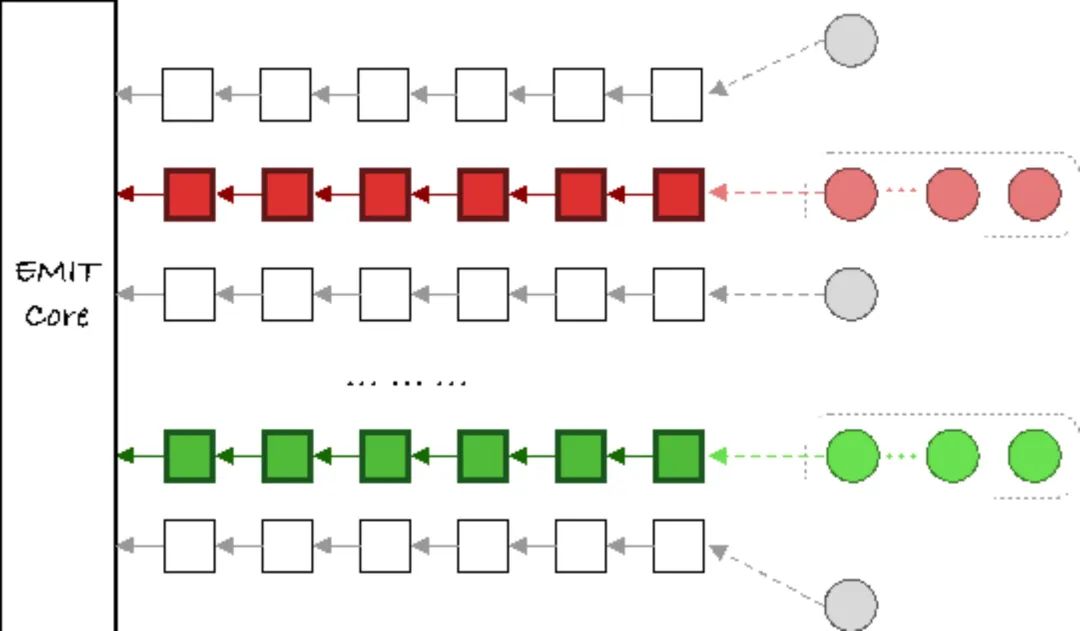
image description
Data source: "EMIT White Paper" https://osf.io/bymuk/
The vision of the EMIT project itself is to "integrate the assets of the encrypted world and create a decentralized world with complete economy". In the EMIT project, bridges between China Unicom’s Ethereum, Binance Smart Chain, Tron, Super ZERO and other decentralized networks have been built, and there is an EMIT-Epoch sub-project that is constantly absorbing and expanding the entire ecology. These are all built on the basis of EMIT-Core technology. So far, EMIT already has its own cross-chain wallet and ecological applications such as Cross, Chaos, Altar, TeamMining, StarGrid, RelicsMarket, Accounts, Assets, Bangs, etc. Gradually increase over time, and eventually form an economically complete decentralized world.
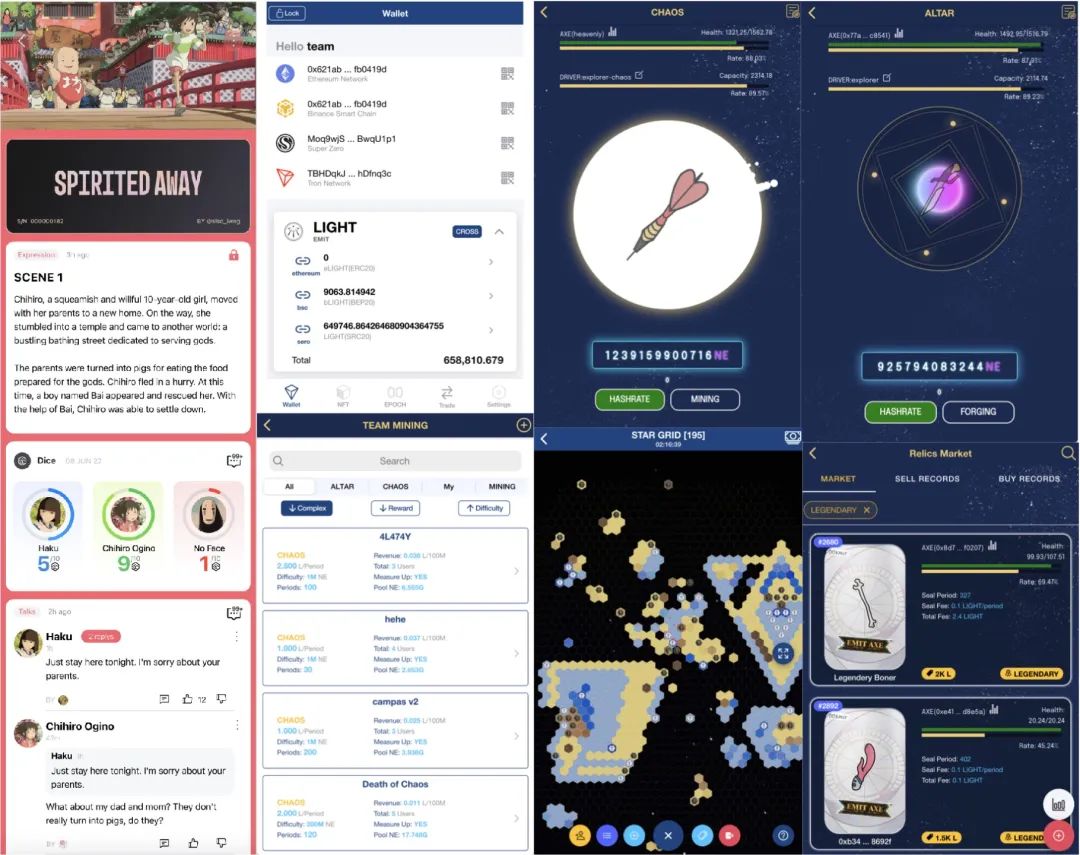
first level title
Value imagination and potential risks
first level title
Summarize
Summarize
Compared with the new public chain whose valuation is still high in the bear market, we should not ignore the characteristic public chain that is under construction and has a relatively reasonable valuation. Perhaps it is not the Fork of Ethereum, but a more disruptive public chain that can help Web3.0 to mature.At present, the development of the public chain we have observed tends to be modular, loosely coupled and parallel to the vertical application field. The general-purpose L1 market such as Ethereum is gradually becoming popular, and the merger of ETH2.0 and the completion of fragmentation expansion does not mean ETH It can fully carry the potential incremental users of Web3.0. For example, if an application has 10,000 users before expansion, and the influx of 10 million users later increases the TPS requirements of the public chain by 1,000 times, simply expanding the capacity by 1,000 Times obviously cannot afford these incremental users' demands for high performance. Even if it is crowded,
The development of characteristic public chains may give birth to some new applications and business models that we cannot imagine in the current state. As for what new applications and models will be unlocked, we can at least expect the next generation of Internet The blessing of blockchain technology brings us an experience that is several times better than Web2.0.
【Reference】
[1]Li Xi,【Reference】
[2]Tony, Stewart, Mavis, Jason, Ryan, Luiz,Solana Ecological Report, First Class
[3]Kunal Goel,《Mina Protocol - Small but Mighty》, Messari
[4]medium.com/aptoslabs/block-stm-how-we-execute-over-160k-transactions-per-second-on-the-aptos-blockchain-3b003657e4ba
[5]docs.minaprotocol.com/static/pdf/technicalWhitepaper.pdf
[6]wiki.assembly.sc/learn/introduction
[7]coinyuppie.com/composability-vs-modularity-who-is-the-c-bit-of-the-blockchain/
[8]cointelegraphcn.com/news/mysten-labs-sui
[9]blockcast.it/2022/08/03/sui-a-blockchain-built-by-former-meta-developers/
disclaimer
disclaimer